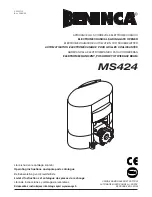
Check working condition of door before installing the operator. Door must be free from sticking and
binding. If equipped, deactivate any door locking device(s). Door repairs and adjustments, including
cables and spring assemblies MUST be made by a trained service representative using proper tools and
instructions.
CAUTION
!
ATTENTION
!
Vérifiez l’état de fonctionnement de la porte avant d’installer l’opérateur. La porte doit pouvoir bouger
librement et ne pas coincer. Désactivez tous les dispositifs de verrouillage de la porte (si équipés). Les
réparations et les réglages de porte, plus particulièrement pour les câbles et les ressorts DOIVENT être
effectués par un technicien qualifié qui se sert d’outils appropriés et qui respecte les instructions.
DO NOT apply line voltage until instructed to do so.
WARNING
!
AVERTISSEMENT
!
NE PAS mettre sous tension tant que l’instruction n’est pas donnée de le faire.
Job Site Issues to Consider/Concerns
The following list of items should be considered prior to selecting an operator for a given job site.
1. Available power supply.
2. Type of door.
3. Potential operator mounting obstructions. Items to consider include, but are not limited to: Room
above door shaft, room below door shaft, available mounting surface integrity, power supply location,
and convenient release cable positioning.
4. Size of door for appropriate operator torque and door travel speed selection.
5. Operator mounting environment. Items to consider include operator location, dampness of location,
dustiness of the location and corrosiveness of the location.
6. Door activation needs/requirements. Examples include 3 button control stations, 1 button control
stations, radio controls, pull cords, loop detectors, photoelectric controls, key switches, etc. See
ENTRAPMENT PROTECTION Sec-1.5.
7. Interlock switches are required under certain conditions for doors with pass doors, door lock and dock
levelers.
8. Accessory equipment. Examples include reversing edges and/or photocell beams, which are required
for doors set to operate as momentary contact, auxiliary control relays, warning lights, etc. See
ENTRAPMENT PROTECTION Sec-1.5.
Section 1: General Information & Instructions
Sec-1.1




































